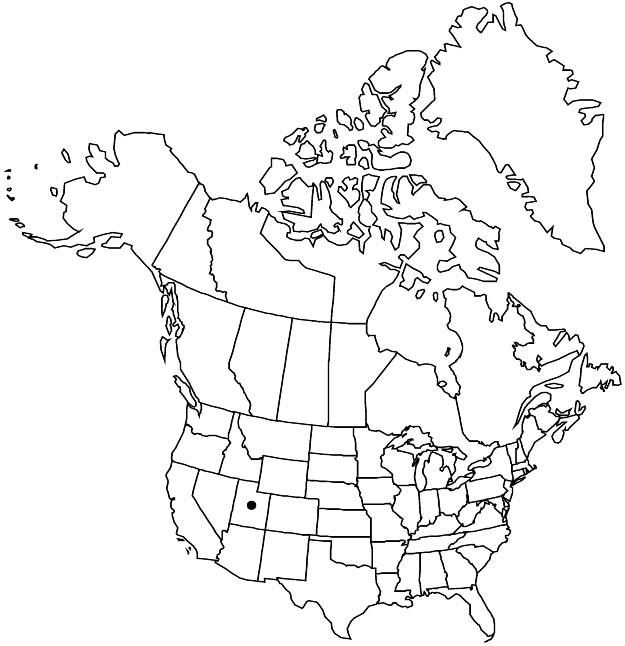Difference between revisions of "Eriogonum brevicaule var. cottamii"
Great Basin Naturalist 32: 113. 1972.
FNA>Volume Importer |
FNA>Volume Importer |
||
| Line 11: | Line 11: | ||
|name=Eriogonum tenellum subsp. cottamii | |name=Eriogonum tenellum subsp. cottamii | ||
|authority=S. Stokes | |authority=S. Stokes | ||
| + | |rank=subspecies | ||
|publication_title=Eriogonum, | |publication_title=Eriogonum, | ||
|publication_place=70. 1936 (as cottami) | |publication_place=70. 1936 (as cottami) | ||
| Line 29: | Line 30: | ||
|elevation=1300-2100 m | |elevation=1300-2100 m | ||
|distribution=Utah. | |distribution=Utah. | ||
| − | |discussion=<p>Variety cottamii is infrequent in the desert ranges west of the Wasatch Range in eastern portions of Juab, Millard, and Tooele counties, the southwestern corner of Salt Lake County, and in western Utah County. The attractive tomentum of Cottam’s wild buckwheat changes from a gray to tannish- or reddish-brown as the plant matures, and the species is worthy of horticultural consideration. The narrow leaf blades of < | + | |discussion=<p>Variety cottamii is infrequent in the desert ranges west of the Wasatch Range in eastern portions of Juab, Millard, and Tooele counties, the southwestern corner of Salt Lake County, and in western Utah County. The attractive tomentum of Cottam’s wild buckwheat changes from a gray to tannish- or reddish-brown as the plant matures, and the species is worthy of horticultural consideration. The narrow leaf blades of <i></i>var.<i> cottamii</i> readily distinguish it from the more western <i>E. natum</i>.</p> |
|tables= | |tables= | ||
|references= | |references= | ||
| Line 38: | Line 39: | ||
-->{{#Taxon: | -->{{#Taxon: | ||
name=Eriogonum brevicaule var. cottamii | name=Eriogonum brevicaule var. cottamii | ||
| − | |||
|authority=(S. Stokes) Reveal | |authority=(S. Stokes) Reveal | ||
|rank=variety | |rank=variety | ||
| Line 53: | Line 53: | ||
|publication year=1972 | |publication year=1972 | ||
|special status= | |special status= | ||
| − | |source xml=https://jpend@bitbucket.org/aafc-mbb/fna-data-curation.git/src/ | + | |source xml=https://jpend@bitbucket.org/aafc-mbb/fna-data-curation.git/src/f50eec43f223ca0e34566be0b046453a0960e173/coarse_grained_fna_xml/V5/V5_503.xml |
|subfamily=Polygonaceae subfam. Eriogonoideae | |subfamily=Polygonaceae subfam. Eriogonoideae | ||
|genus=Eriogonum | |genus=Eriogonum | ||
Revision as of 21:54, 16 December 2019
Plants erect, 1–3.5 × 2–5 dm. Aerial flowering stems erect, 0.5–2 dm, tomentose. Leaves: blade narrowly oblanceolate to narrowly elliptic; leaf blades (2–)3–4(–4.5) × 0.3–0.5(–0.7) cm, margins plane. Inflorescences cymose, usually divided 3 or more times, 2–7 cm; branches tomentose. Involucres usually 1 per node, turbinate, 2–3(–3.5) × 1.5–2(–2.5) mm, tomentose. Flowers (2.5–)3–4 mm; perianth yellow, glabrous.
Phenology: Flowering Jun–Sep.
Habitat: Gravelly limestone slopes and clay hills, sagebrush communities, oak and pinyon-juniper woodlands
Elevation: 1300-2100 m
Discussion
Variety cottamii is infrequent in the desert ranges west of the Wasatch Range in eastern portions of Juab, Millard, and Tooele counties, the southwestern corner of Salt Lake County, and in western Utah County. The attractive tomentum of Cottam’s wild buckwheat changes from a gray to tannish- or reddish-brown as the plant matures, and the species is worthy of horticultural consideration. The narrow leaf blades of var. cottamii readily distinguish it from the more western E. natum.
Selected References
None.
